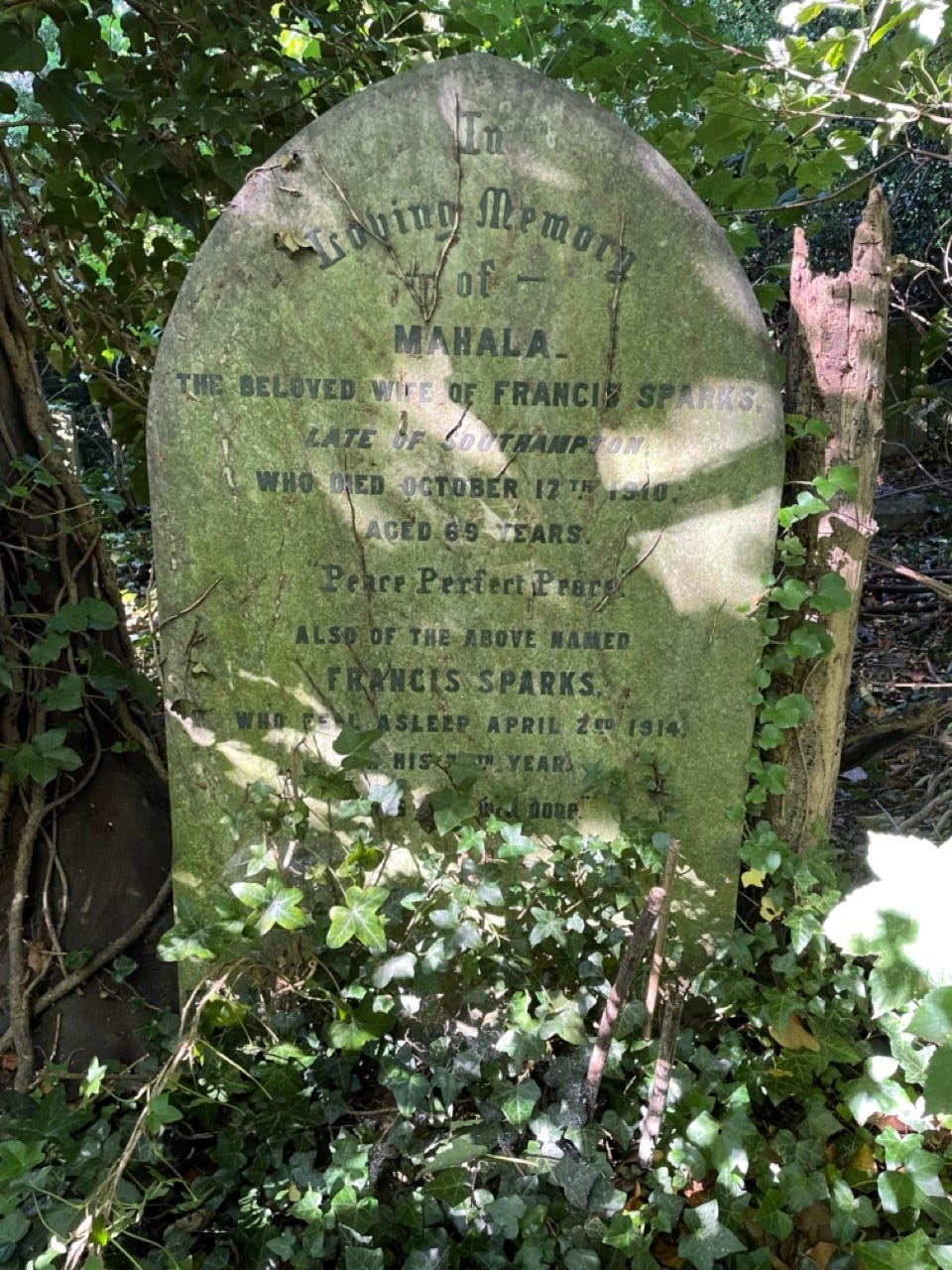Walking with ghosts
For my first Writer's Walkshop I took a group on a stroll around Abney Park Cemetery and we celebrated its residents' stories
Content advice: cemeteries, graves, memorials, remembrance
Hello, hello! What walks do you have planned this summer? Let me know what you’re up to by commenting on this post or tagging me on Instagram (@thewriterswalk).
Walking
Jon Hawkins, a brand writer I often work with, asked me to run a real-life version of The Writer’s Walk as part of a team day. But this couldn’t be any old walking and writing workshop. He wanted me to lead a walk with the dead in Stoke Newington’s Abney Park Cemetery.
Abney Park is one of London’s ‘magnificent seven’ cemeteries, which were opened in the 19th century to help relieve the overcrowding in the city’s parish burial grounds. Uniquely for London, it was designed as an arboretum, with 2,500 varieties of plants, and collections of oaks, thorns, pines and other trees planted alphabetically around the perimeter. It was a working cemetery until the 1970s when it went into administration and fell into disrepair. It was taken over by Hackney Borough Council in the 1980s and is now managed by a small, volunteer-led charity, Abney Park Trust, who are slowly restoring it in partnership with the council.
The magnificent seven cemeteries serve the dual role of being places of remembrance and providing Londoners with vital green spaces. Abney is now a nature reserve and public park where people walk their dogs, sit beneath the trees to eat their lunch, meet friends or go for a run. There are regular events, including history and plant identification tours and even the occasional wood-carving workshop.
There are over 200,000 people laid to rest in Abney Park, many of them famous like William and Catherine Booth, founders of the Salvation Army, and Margaret Graham, the first woman to make a solo balloon flight.
But while a lot is known about Abney’s famous residents, including religious dissenters, writers, abolitionists and entertainers, many graves are unmarked, damaged or hidden beneath the unruly plants and trees. I wanted us to explore Abney’s overgrown corners to find forgotten memorials and imagine the people they were dedicated to and the lives they may have led. So after a brief chat about its history, I invited the group to explore the park, find a headstone, statue or memorial that intrigued them, and imagine the person’s story. Here are a few of our discoveries.
Pete Cornes discovered a family grave with a mysterious reference to their ‘wife’s mother’ who seemed to be mentioned as an afterthought:
Emma Wilkin noticed this bird, keeping watch over Louisa’s ‘sacred’ grave:
Jo Simpson pondered the lives of Dorothy Watson and her parents Elizabeth and Frederick Spratt:
Jon shared the headstone of the intriguingly named Ethel Florence Fluck:
And I discovered Mahala and tried to imagine where she was born, how she might have met and married a man from Southampton, and how she ended up in London:
We then shared the stories we imagined for each person, honouring their lives and the small and varied ways in which they might have made a difference in the world.
So for your walk this time, I invite you to explore a cemetery1. Search out the headstones or memorials that seem to be forgotten – perhaps ones that are broken, or overgrown with ivy or weeds, or do not have an epigraph. Then imagine who the person might have been and take a moment to remember them.
Writing
Over time, the stories of the people in a cemetery can fade from memory. Time and weather can wear away the epigraphs on headstones, graveyard records might be lost, or the person might have died so long ago there’s no one left who remembers them. So our aim was to honour the people we found by trying to picture who they were, where they came from, and what made them special.
So for your writing this time, I’d like you to write the story of the person you found.
Who do you imagine they were? Where did they come from? Did they travel the world? Were they wealthy or poor, generous or miserly? Where did they go to school? Did they even go to school? What was their job? And what did they look like? Finally, try and imagine something they might have done that made a difference. Maybe they invented something we all take for granted now, set a new record in sport, broke new ground in art or transformed what we know about science. Celebrate this forgotten person by writing their story.
Happy walking and writing until next time,
Sarah
Please be respectful when exploring cemeteries, especially if they’re still in use or visited by people paying respects to loved ones. Be careful not to step on the graves or any flowers or memorabilia left there. If you’re unsure, you could visit an older cemetery that’s no longer in use or one that’s been designated as a public park or nature reserve, like Abney Park.







